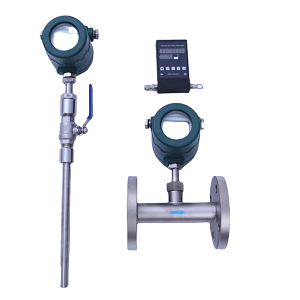At present, the biogas market is very active and is developing very rapidly. Biogas has many uses, such as using biogas as a vehicle fuel, or using biogas to generate electricity and heat in a cogeneration plant. For biogas production equipment, we also need to monitor biogas flow rate, the fermentation temperature and digesters pressure to ensure the safety and proper operations.
Biogas is a gas that is very difficult to measure. It has the following technical characteristics:

At present, there are several biogas flow metering technologies that have been widely used in biogas, including thermal mass flow meters, turbine flowmeters, vortex flowmeters, orifice flowmeters, and ultrasonic gas flowmeters. However, due to the low biogas pressure, large changes in the flow rate of biogas components, strong corrosiveness, and viscous impurities, these flow metering techniques also have some application problems, which cause troubles for flow meter stability and routine maintenance.
Silver Automation Instruments supply good quality and economical biogas flow meters, welcome to contact us for more information.
 Thermal Mass Flow Meter2017/05/27Low cost gas flow meter.
Thermal Mass Flow Meter2017/05/27Low cost gas flow meter. Micro-Flowrate Thermal Mass Flow Meter2018/03/02Micro-flowrate Thermal mass flow meter
Micro-Flowrate Thermal Mass Flow Meter2018/03/02Micro-flowrate Thermal mass flow meter Gas Turbine Flow Meter2017/04/12Robust Gas flow meter for natural gas,LPG,biogas flow measurement.Inquiry Gas TUF Flowmeter price with EVC directly from China manufacture.VIEW
Gas Turbine Flow Meter2017/04/12Robust Gas flow meter for natural gas,LPG,biogas flow measurement.Inquiry Gas TUF Flowmeter price with EVC directly from China manufacture.VIEW Gas Flow meter2018/11/14Gas flow meter is a kind of flow measuring instruments that measure the flow of a gas. This article talks about mainly gas flow instruments such as thermal mass flow meter, vortex shedding flow sensor ,turbine flowmeter,rotameter.VIEW
Gas Flow meter2018/11/14Gas flow meter is a kind of flow measuring instruments that measure the flow of a gas. This article talks about mainly gas flow instruments such as thermal mass flow meter, vortex shedding flow sensor ,turbine flowmeter,rotameter.VIEW LPG/propane mass flow meter2019/05/10We utilize Coriolis flow meter (CMF) to take measurement of LPG/propane mass flow. It has high accuracy flow measurement, can measure mix state of LPG , can be used as custody transfer flow meter.VIEW
LPG/propane mass flow meter2019/05/10We utilize Coriolis flow meter (CMF) to take measurement of LPG/propane mass flow. It has high accuracy flow measurement, can measure mix state of LPG , can be used as custody transfer flow meter.VIEW Vortex Flow Meter2017/04/12Vortex Flow meter is for clean liquid, gas and steam flow measurement. Contact us to choose proper type flow sensor and get the competitive quotation.VIEW
Vortex Flow Meter2017/04/12Vortex Flow meter is for clean liquid, gas and steam flow measurement. Contact us to choose proper type flow sensor and get the competitive quotation.VIEW